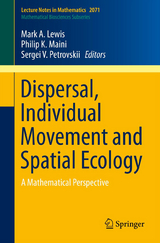Dispersal, Individual Movement and Spatial Ecology
Springer Berlin (Verlag)
978-3-642-35496-0 (ISBN)
Part I: Individual Animal Movement.- 1. Stochas-tic optimal foraging theory.- 2. Levy or not? Analysing positional data from animal movement paths.- 3. Beyond optimal searching: Recent developments in the modelling of animal movement patterns as Levy walks.- Part II: From Individuals to Populations.- 4. The mathematical analysis of biological aggregation and dispersal: progress, problems and perspectives.- 5. Hybrid modelling of individual movement and collective behaviour.- 6. From individual movement rules to population level patterns: the case of central-place foragers.- 7. Transport and anisotropic diffusion models for movement in oriented habitats.- 8. Incorporating complex foraging of zooplankton in models: role of micro- and mesoscale processes in macroscale patterns.- Part III: Populations, Communities and Ecosystems.- 9. Life on the move: modeling the effects of climate-driven range shifts with integrodifference equations.- 10. Control of competitive bioinvasion.- 11. Destruction and diversity: effects of habitat loss on ecological communities.- 12. Emergence and propagation of patterns in nonlocal reaction-diffusion equations arising in the theory of speciation.- 13. Numerical study of pest population size at various diffusion rates.
| Erscheint lt. Verlag | 5.4.2013 |
|---|---|
| Reihe/Serie | Lecture Notes in Mathematics | Mathematical Biosciences Subseries |
| Zusatzinfo | XIV, 385 p. 96 illus., 49 illus. in color. |
| Verlagsort | Berlin |
| Sprache | englisch |
| Maße | 155 x 235 mm |
| Gewicht | 601 g |
| Themenwelt | Informatik ► Weitere Themen ► Bioinformatik |
| Mathematik / Informatik ► Mathematik ► Angewandte Mathematik | |
| Schlagworte | Biological invasion • Dispersal • Hybrid modelling • M31000, M13003, L19147, L19007, M13090, M14068 • pattern formation |
| ISBN-10 | 3-642-35496-3 / 3642354963 |
| ISBN-13 | 978-3-642-35496-0 / 9783642354960 |
| Zustand | Neuware |
| Haben Sie eine Frage zum Produkt? |
aus dem Bereich




